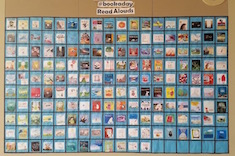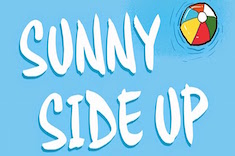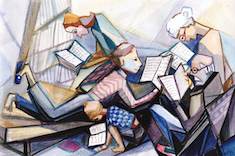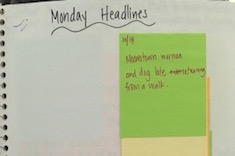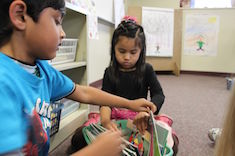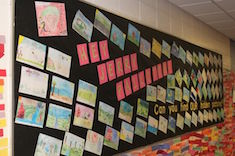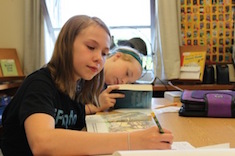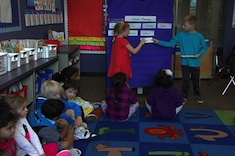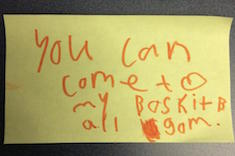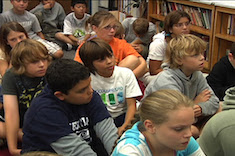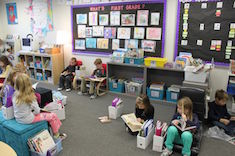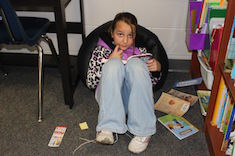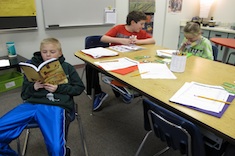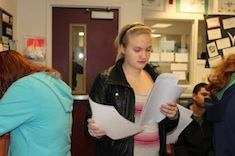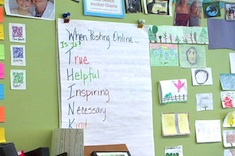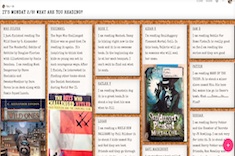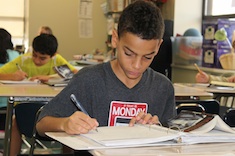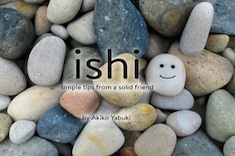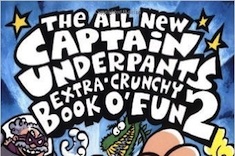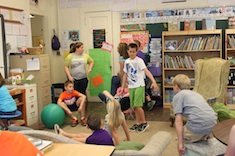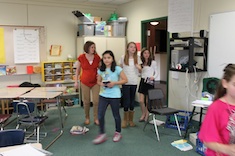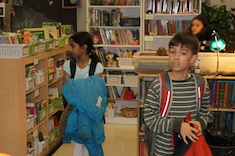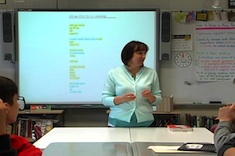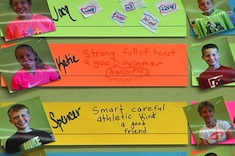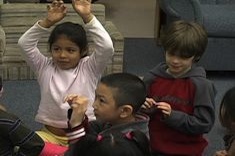Community Building
It's one of the big paradoxes of literacy instruction - students best learn how to read and write independently when they have a strong community of support in classrooms. How teachers build those thoughtful, kind, and challenging classroom communities is explained in these resources.
Latest Content
#bookaday in Middle School: Nuts and Bolts
Jillian Heise shares advice for teachers who want to try a #bookaday challenge of sharing at least one picture book each day with older students. She gives criteria for book selection, as well as examples of books to read at the start of the school year.
Building Community with a Shared Text
Christy Rush-Levine finds a community of new teachers bonds over a text highlighting addiction struggles. The experience leads her to think through what elements are essential for whole-class texts in her middle school classroom.
#bookaday in Middle School
Jillian Heise rises to the challenge of reading a new picture book to her seventh and eighth graders each day all year long.
Building Community and Family Connections
Tara Barnett and Kate Mills share suggestions for connecting with parents over the summer and early in the school year, including some fun uses of technology.
Monday Headlines
Tara Barnett and Kate Mills use Monday Headlines to energize students after the weekend, and get a peek into what’s going on at home.
Reading Ambassadors
Cathy Mere finds that a Reading Ambassadors program pays big dividends in building confident and conversant young readers.
Hosting Reading and Writing Events
Gigi McAllister explains why you have to be a bit choosy about reading and writing events since there are so many possibilities. Here are some she values in her fourth-grade classroom.
Building Excitement for Book Awards
Bitsy Parks finds building excitement for book awards works in tandem with generating enthusiasm for reading in her first-grade classroom.
Supporting Introverts in Fifth Grade
Katherine Sokolowski was that shy child hiding behind a tall classmate in the back of the room when she was a student. As a teacher, she makes sure there are many ways she helps bring out the voices of introverts in her fifth-grade classroom.
Starting the Day with Literacy
Bitsy Parks shares how she starts the day with literacy in her first-grade classroom.
Reminder Notes
Bitsy Parks teaches her first graders to write sticky note reminders throughout the day, and is delighted by the learning and community building that ensues.
Read-Aloud Gone Awry
Jennifer Schwanke shares her experience of having read-aloud go awry in a middle school classroom.
In Search of Just-Right Reading Spots
If children can choose just-right reading spots, they will have more stamina for reading. Heather Fisher explains how she works with first-grade teachers and students to build this skill.
Supporting Brave Writers
Tara Barnett and Kate Mills use the Sara Bareilles song “Brave” to help their fourth-grade students move from bed-to-bed stories to more emotive writing early in the year.
Creating a Culture of Book Love
Tara Smith shares some of her favorite online resources for keeping up with new books, as well as organizing tips for classroom libraries.
An Identity of Success
Mary Lee Hahn is a bit flummoxed when a parent asks about her management system at an open house. The experience sparks reflection on what makes a classroom community gel.
An Unconventional Scavenger Hunt: Finding Errors
Jennifer Schwanke finds that a scavenger hunt for errors to add to a bulletin board is a great way to build editing skills and a writing community all year long in her seventh-grade classroom.
Guidelines for Posting Online
Katherine Sokolowski describes a wall display with guidelines to ensure students are respectful and aware of the pitfalls of posting online.
Padlet Possibilities
Katherine Sokolowski finds that electronic charting of learning with Padlet has almost endless possibilities for use in her fifth-grade classroom.
Better Mondays Through Quick-Writes
Mark Levine uses quick-writes with his middle school students to set the expectation at the start of the week for work together that is independent, thoughtful, and conversational.
Opening the Year with Optimism
Katrina Edwards shares her plans for presenting children’s literature to help her first-grade students acquire the skills they need to be positive and proactive problem solvers.
Critical Thinking and Captain Underpants
Christy Rush-Levine and some struggling eighth-grade readers consider misogyny in a popular children’s book.
Who Owns the Room?
Katherine Sokolowski considers how classroom design says a lot about the relationship between students and teachers.
“What Are We Learning Today?”: Transitioning with Compelling Questions
Mark Levine helps his seventh-grade students transition to the learning of the day with a "compelling question" posted on the board before each class session.
Transition Time in Middle School
Gretchen Taylor considers how she handles hard transitions as an adult, and questions how she can make transitions more efficient and valuable for her middle school students.
Making the Most of Transitions
Tara Barnett and Kate Mills share strategies for meaningful transitions in their fourth-grade classroom.
Reflective Transitions
Christy Rush-Levine helps her eighth-grade students launch the work period with a reflective question that sets a tone for productivity, and then returns to it throughout the morning during transition times.
Student Interest Board
Katherine Sokolowski shares a wall display from her fifth graders that students build to celebrate who they are and people they love from home.
Creating a Space for Peace
At a time of escalating violence throughout the world, children need peaceful spaces. Katie DiCesare creates a "peace table" in her first-grade classroom as a safe place for working through everything from playground squabbles to emotional distress.
Fostering Thinking Through Play
Katie DiCesare repurposes materials for her first graders to play with, and finds that encouraging play early in the year is a great tool for building reflection skills.
Browse Content By
Type
Category
- Assessment Tools
- Big Fresh Archives
- Booklists
- Choice Numeracy
- Classroom Design
- Common Core
- Community Building
- Conferring
- Content Literacy
- Digital Literacy
- English Language Learners
- Equity
- Family Relations
- Free Samples
- Guiding Groups
- Leadership
- Literacy Coaches
- Mentor Texts
- Minilessons
- New Teacher Mentors
- Podcasts
- Poetry
- Quote Collections
- Reading Strategies
- Self Care
- Struggling and Striving Learners
- Talking and Listening
- Teacher Study Groups
- Teaching Reading
- Teaching Writing
- Word Study and Vocabulary
Author
- Melissa Quimby
- Nawal Qarooni
- Gwen Blumberg
- Julie Cox
- The Lead Learners
- Hannah Tills
- Josie Stewart
- Ruth Metcalfe
- Mallory Messenger
- Becca Burk
- Jodie Bailey
- Vivian Chen
- Mary Brower
- Tiffany Abbott Fuller
- Stephanie Affinito
- Ruth Ayres
- Leigh Anne Eck
- Heather Fisher
- Shari Frost
- Julie Johnson
- Suzy Kaback
- Gigi McAllister
- Shirl McPhillips
- Melanie Meehan
- Cathy Mere
- Debbie Miller
- Tara Barnett and Kate Mills
- Tammy Mulligan
- Dana Murphy
- Bitsy Parks
- David Pittman
- Brenda Power
- Heather Rader
- Matt Renwick
- Mandy Robek
- Christy Rush-Levine
- Gretchen Schroeder
- Jen Schwanke
- Brian Sepe
- Katherine Sokolowski
- Stella Villalba
- Jennifer Vincent
Grade Level
Choice Literacy Membership
Articles
Get full access to all Choice Literacy article content
Videos
Get full access to all Choice Literacy video content
Courses
Access Choice Literacy course curriculum and training

